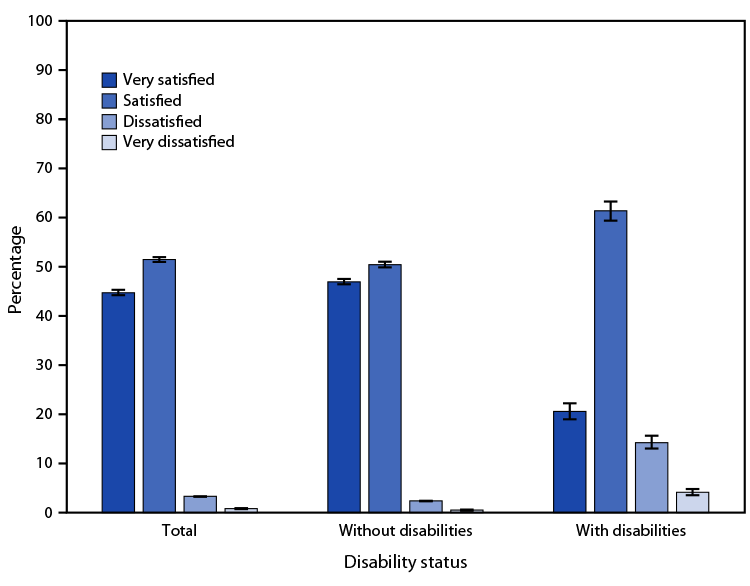QuickStats: Age-Adjusted Percentage* of Adults Aged ≥18 Years Who Reported Their Level of Satisfaction with Life,† by Disability Status§ — National Health Interview Survey,¶ United States, 2022
Weekly / December 22, 2023 / 72(51);1383

* Age-adjusted percentages are based on the 2000 U.S. Census Bureau standard population, using age groups 18–44, 45–54, 55–64, 65–74, and ≥75 years, with 95% CIs indicated by error bars.
† Based on responses to the survey question, “In general, how satisfied are you with your life? Would you say very satisfied, satisfied, dissatisfied, or very dissatisfied?”
§ Disability was defined by the reported level of difficulty to questions about six domains of functioning: “Do you have any difficulty… seeing, even if wearing glasses; hearing, even if wearing hearing aids; walking or climbing stairs; communicating, for example understanding or being understood; remembering or concentrating; and administering self-care, such as washing all over or dressing.” Response categories were “no difficulty,” “some difficulty,” “a lot of difficulty,” or “cannot do at all.” Adults who responded “a lot of difficulty” or “cannot do at all” to at least one domain were classified with disability.
¶ Estimates are based on household interviews of a sample of the civilian, noninstitutionalized U.S. population.
In 2022, 44.6% of adults aged ≥18 years reported they were very satisfied with their life, 51.3% reported they were satisfied, 3.3% reported they were dissatisfied, and 0.8% reported they were very dissatisfied. Adults without disabilities were more likely to be very satisfied (46.8%) or satisfied (50.3%) with their life than dissatisfied (2.4%) or very dissatisfied (0.5%). Adults with disabilities were more likely to be satisfied with their life (61.2%) compared with very satisfied (20.5%), dissatisfied (14.2%), or very dissatisfied (4.1%). Adults without disabilities were more likely than adults with disabilities to be very satisfied with their life. Conversely, adults with disabilities were more likely than adults without disabilities to be satisfied, dissatisfied, or very dissatisfied.
Source: National Center for Health Statistics, National Health Interview Survey, 2022. https://www.cdc.gov/nchs/nhis/index.htm
Reported by: Julie D. Weeks, PhD, jweeks@cdc.gov; Jennifer H. Madans, PhD; Nazik Elgaddal, MS.
For more information on this topic, CDC recommends the following link: https://www.cdc.gov/ncbddd/disabilityandhealth/index.html
Suggested citation for this article: QuickStats: Age-Adjusted Percentage of Adults Aged ≥18 Years Who Reported Their Level of Satisfaction with Life, by Disability Status — National Health Interview Survey, United States, 2022. MMWR Morb Mortal Wkly Rep 2023;72:1383. DOI: http://dx.doi.org/10.15585/mmwr.mm7251a5.
MMWR and Morbidity and Mortality Weekly Report are service marks of the U.S. Department of Health and Human Services.
Use of trade names and commercial sources is for identification only and does not imply endorsement by the U.S. Department of
Health and Human Services.
References to non-CDC sites on the Internet are
provided as a service to MMWR readers and do not constitute or imply
endorsement of these organizations or their programs by CDC or the U.S.
Department of Health and Human Services. CDC is not responsible for the content
of pages found at these sites. URL addresses listed in MMWR were current as of
the date of publication.
All HTML versions of MMWR articles are generated from final proofs through an automated process. This conversion might result in character translation or format errors in the HTML version. Users are referred to the electronic PDF version (https://www.cdc.gov/mmwr) and/or the original MMWR paper copy for printable versions of official text, figures, and tables.
Questions or messages regarding errors in formatting should be addressed to mmwrq@cdc.gov.